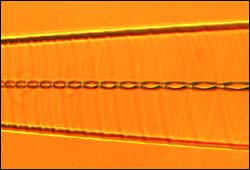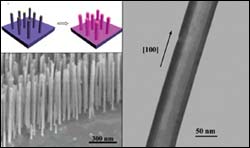This topic covers issues related to energy generation, conversion, transportation and consumption and how the industry is addressing the challenge of energy efficiency in general.
innovations-report provides in-depth and informative reports and articles on subjects ranging from wind energy, fuel cell technology, solar energy, geothermal energy, petroleum, gas, nuclear engineering, alternative energy and energy efficiency to fusion, hydrogen and superconductor technologies.

UH researchers developing efficient, practical power source alternatives
As temperatures soar this summer, so do electric bills. Researchers at the University of Houston are striving toward decreasing those costs with the next revolution in power generation.
Imagine a power source so small, yet so efficient, that it could make cumbersome power plants virtually obsolete while lowering your electric bill. A breakthrough in thin film solid oxide fuel cells (SOFCs) is curren

Add a deceptively simple twist to a tiny fiber of glass and you get a versatile new class of optical devices to filter light; sense changes in temperature, pressure or other environmental factors; or transmit information via powerful, inexpensive lasers, according to researchers at Chiral Photonics Inc. of Clifton, N.J. Writing in the July 2 issue of Science, the company describes a new class of devices called chiral gratings that were developed with support from the Advanced Technology Program at t

’we can supply a group of previously unavailable materials to the nanotechnology community’
A University of Southern California engineer has discovered a way to manufacture composite “nanocables” from a potent new class of substances with extraordinary properties called Transition Metal Oxides (TMOs).
Chongwu Zhou, an assistant professor in the USC Viterbi School of Engineering’s Department of Electrical Engineering, is creating dense arrays of ultrafine wires made of magn

As previously informed, Vestas has experienced a series of problems with the operation of the offshore project Horns Reef located in the North Sea, 15 kilometres off the shore near Esbjerg located on the Danish west coast.
Harsh environment
The environment at Horns Reef is harsh and it has been ascertained that all transformers and a number of generators had to be changed. In close and constructive collaboration with the customer, the Danish utility Elsam, Vestas and ABB a

Spiraling glass fibers provide new way to control behavior of light By twisting fiber optic strands into helical shapes, researchers have created unique structures that can precisely filter, polarize or scatter light. Compatible with standard fiber optic lines, these hair-like structures may replace bulky components in sensors, gyroscopes and other devices. While researchers are still probing the unusual properties of the new fibers, tests show the strands impart a chiral, or

To become the world’s most competitive powerhouse, Europe must lead the transition of the micro-electronics sector to the next generation of nano-electronics, with co-ordinated public and private investments of at least €6 billion per year. This is the message from a report drawn up by CEOs of leading companies and research organisations and presented today to European Research Commissioner Philippe Busquin and Enterprise and Information Society Commissioner Erkki Liikanen. Smarter and smaller elec